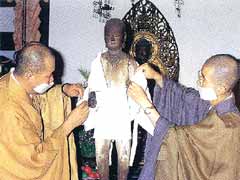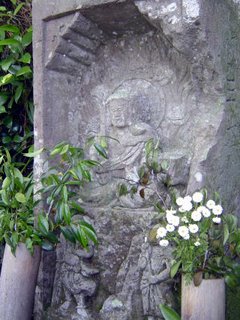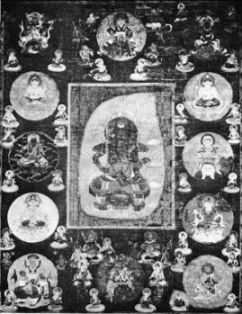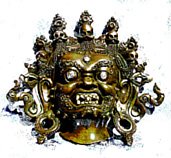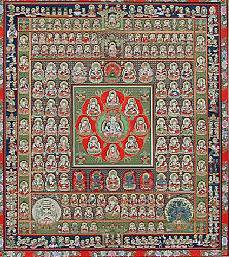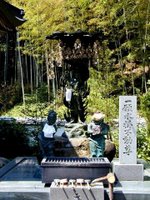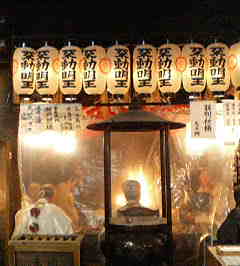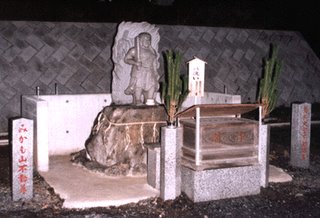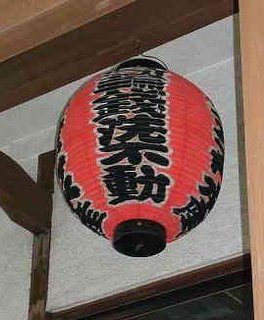. Introducing Buddha Statues .
:::::::::::::::::::::::::::::::::::::::::::::::::::::::::::::::::::::::::::::::::::::::::::::::::::::
Sun and Moon Deities of Japan
Amaterasu Oomikami, the Great Sun Godess 天照大神
Dainichi Nyorai The Great Sun 大日如来
:::::::::::::::::::::::::::::::::::::::::::::::::::::::::::::::::::::::::::::::::::::::::::::::::::::
Nikko Bosatsu (Sunlight)
Gakko Bosatsu (Moonlight)
日光菩薩と月光菩薩
Suryaprabha and Candraprabha
They were thought to be the children or attendants of Yakushi Nyorai.
One way to distinquish between the two is to look for the Gachirin symbol (月輪 = Moon Disc). The Gachirin (also called Gatsurin or Getsurin) is a perfectly round circle meant to represent the full moon, a frequently used symbol in Buddhist painting and sculpture. It represents the Buddha's knowledge and virtue and symbolizes the aspirations of sentient beings to attain Buddhahood. The Gachirin is a key attribute of Gakkou Bosatsu, who is often shown in statues and paintings wearing a headpiece representing the moon or holding a circular form in the palm of his hand.
Read the basic information from Mark Schumacher

日輪、月輪を持つ.
病気平癒・身体健全・除病延寿・災難除去. 薬師如来を信仰する者を守護
http://www.butsuzou.com/jiten/nikogako.html
ooo ooo ooo ooo ooo ooo ooo ooo
Cultural Property from Sendai 仙台の文化財
From the Edo Period, 1645
Carved from one piece of wood each. The eyes are carved in natural form and whitend with powder (gofun).

江戸時代(正保2年/1645)
寛慶円信が作ったという
http://www.city.sendai.jp/kyouiku/bunkazai/database/c0000000221.html
ooo ooo ooo ooo ooo ooo ooo ooo
Nikko and Gekko Bosatsu. Kofukuji Temple Nara
奈良市の興福寺
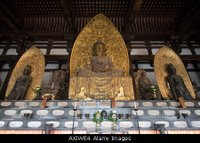
Alamy Stock Photography.
http://www.alamy.com/stock_photography/6/1/Jon+Bower/AXJWE4.html
. Yakushi sanzon 薬師三尊 Yakushi Triad, Trias, Trinity .
with Nikko and Gakko.
:::::::::::::::::::::::::::::::::::::::::::::::::::::::::::::::::::::::::::::::::::::::::::::::::::::
Nitten and Gatten, the Hindu Gods of Sun and Moon
Great Heavenly Sun King
Great Heavenly Moon King
Nitten is also thought of as an incarnation of Kannon Bosatsu.
Gatten sometimes holds a half moon with a rabbit in it.
Look at two paintings from the emuseum of the TNM.
Nitten, Sūrya, Āditya 日天

Gatten, Candra 月天

http://www.emuseum.jp/cgi/bunsyutu.cgi?SyoID=1&ID=w015&SubID=s001
http://www.emuseum.jp/cgi/bunsyutu.cgi?SyoID=1&ID=w015&SubID=s002
ooo ooo ooo ooo ooo ooo ooo ooo
Nitten
He holds a jewel representing the sunlight. Rides on a horse with three or five heads, even seven heads. In the old Indian stories of the deities, the sun god in a charriot with many horses was common.
手に太陽を示す日珠を持っています。三頭または五頭の馬に乗ったものや七頭の馬が牽く車に乗る姿もあります。
古代インド神話では、太陽を中心として神格化した神様は多く、馬に乗って天空を駆け回り、恵みをもたらす神様のひとりです。
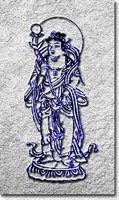
............................................
Gatten
He holds a jewel containing the moonlight. Sometimes he has a staff with a sickle moon and holds a lotus flower.
手に月光の清らかさを示す月珠を持っています。月天もいくつかのバリエーションがあり、三日月の付いた杖や蓮華を持つものもあります。
お釈迦様は苦行の最中に「心に月輪を見よ」という如来の声を聞き、悟りを開くきっかけをつかみました。無染無垢な菩提心が清らかな満月輪にたとえられます。また密教では月輪を例にした五相成身観というものがあります。

Copyright(c), 2000 All rights reserved by Tobifudoson Shoboin.
http://www.tctv.ne.jp/tobifudo/butuzo/12ten/nichi.html
http://www.tctv.ne.jp/tobifudo/butuzo/12ten/getu.html
ooo ooo ooo ooo ooo ooo ooo ooo
Sasara Dance ささら踊り
Shiramazu, Chiba Prefecture 白間津のオオマチ(大祭)
This festival is performed only every four years.
The main deity of this dance are two boys under age of 15, representing Nitten and Gatten.
The festival lasts for 3 days.
祭の中でも最も重視されているもので、その種目は十二ある。「振込み(お寺)」、「振込み(神社)」、「お寺踊り」、「白間津踊り」、「山伏踊り」、「御参宮踊り」、「扇踊り」、「六角踊り」、「小切小踊り(外山)」、「小切小踊り(森屋様)」、「牛若踊り」、「綾踊り」である。
振込みは、境内に入るときの踊りで日天・月天(仲立ち)が先頭に立って行進する。境内に達すると円型に敷かれた席の上で、中心に仲立ちと唄い手を置き、その周囲を廻りながら踊る。踊り手は小学校六年生以下の少女たちで、幼女も加わるたいへん愛らしい踊りです。
Oonawatashi オオナ渡し
The Finale of the Festival
Two groups of boys older than 18 years pull the ropes to get the straw ring in the air. If the group for Nitten looses, there will be a dry spell this year. If the group for Gatten looses, the sea will be wild and bring damage. In this way, the weather for the year is foretold.
At the end of the festival, two large flags for Gatten and Nitten are brought back to the local shrine 日枝神社.

大綱渡しが方言化した呼び名で、文字通り太い綱で、神の依代である大幟を引く祭事です。大幟は都合二本あり、それぞれに日天・月天と区別されています。この日天・月天は杉材に日枝神社の幟旗の上に取り付けるのが、日天・月天をかたどったカサ。竹を輪にして赤い木綿布を周囲にグルリとたらします。
カサは、カサマクともいい、日天のものを「日の出笠」、月天は「曇り笠」とも呼びます。カサの上に取り付けるものは、ハナ。枝だれ式の飾りのことで、ハナの本数は、一日目は十四本、二日目は十五本、三日目は十六本と一本づつ増やしていきます。ハナを飾る飾りはホシと呼ばれ多ければ多いほどいいことになっています。そして、大幟の根元を二十俵ほどの土俵で固めてあります。
http://chikura.awa.or.jp/ivent/oomachi/index.htm
http://www11.plala.or.jp/shimam/event/siramadu.html
ooo ooo ooo ooo ooo ooo ooo ooo
LINK to the Mandala formation with these Deities.
Nr. 63 is Nitten, Nr. 64 is Gatten.
http://mandala.twinstar.jp/k-hotoke(4).htm
:::::::::::::::::::::::::::::::::::::::::::::::::::::::::::::::::::::::::::::::::::::::::::::::::::::
Myooken Bosatsu (Myoken Bosatsu) 妙見菩薩
Myoojoo Tenshi (Myojo tenshi) 明星天子 : Aruna
Nittenji, Gattenji and Myoojoo Tenji are also called the Three Heavenly Children.
The Nichiren Sect of Buddhism has a special affiliation to these Sun and Moon deities.
The Great Mandala, Go Honzon, Nichiren Sect
日天子 (にってんじ)、月天子(がってんじ)、明星天子(みょうじょうてんじ):
三光天子。宝光天子ともいいます。
Star Shrines (Hoshi Jinja 星神社) by Gabi Greve
:::::::::::::::::::::::::::::::::::::::::::::::::::::::::::::::::::::::::::::::::::::::::::::::::::::
Zitat von
Buddhastatuen ... Who is Who
Gakkoo (Candraprabha)
Bosatsu des Mondes, links von Yakushi-Statuen. Auch "Alles beleuchtendes Mondlicht" (Gakkoo Henshoo) genannt.
Immer zusammen mit Nikkoo Bosatsu. Gakkoo und Nikkoo sind die Haupt-Bosatsu im Lapislazuli-Paradies des Yakushi Nyorai. Im Mandala der Mutterschoßwelt findet sich Gakkoo in der Abteilung des Jizoo Bosatsu.
Selten als Dreiergruppe zusammen mit Shaka oder anderen Nyorai.
Symbolisiert nach alten asiatischen Legenden durch einen Hasen oder Frosch (im Mond).
Stellt Intellekt und Rationalität dar; befreit die Menschen von den fleischlichen Lüsten.
Ikonografie:
Meist stehende Statue. Hält eine Mondkugel (gachirin) oder einen Halbmond in der Hand, auf einer langen Lotusblüte oder hat eine Mondkugel oder einen Halbmond in der Hohen Krone. In der Mondkugel kann ein Hase abgebildet sein.
Häufig haben Gakkoo und Nikkoo auch einfach gefaltete Hände.
Unter den fließenden Gewändern befindet sich manchmal eine Rüstung. Daraus kann man schließen, daß es sich bei Gakkoo und Nikkoo eigentlich um Wächtergottheiten handelt, wahrscheinlich den indischen Bonten (Brahma) und den Taishakuten (Indra).
Nikkoo (Suuryaprabha)
Sein vollständiger Name ist "Alles beleuchtendes Sonnenlicht" (Nikkoo Henshoo Bosatsu).
Bosatsu der Sonne, links von Statuen des Yakushi Nyorai. Siehe Gakkoo.
Verkörpert unendliche Tugend wie die Sonnenstrahlen.
Er errettet die in der Dunkelheit der Wiedergeburten leidenden Menschen durch Tausend Sonnenstrahlen, die er vom Himmel herabsendet.
Im Mandala der Mutterschoßwelt findet sich Nikkoo in der Abteilung des Monju Bosatsu.
Symbolisiert nach alten asiatischen Legenden durch die dreibeini~ge Krähe (in der Sonne).
Ikonografie:
Hält eine Sonnenkugel (nichirin) in der Hand oder hat eine Sonnenkugel in der Hohen Krone. Auf der Sonnenkugel kann eine Krähe abgebildet sein. Häufig auch einfach gefaltete Hände.
Seit der Heian-Zeit ist seine Ikonografie einheitlich mit einer Sonnenkugel in einer Lotusblüte.
Buddhastatuen ... Who is Who
Ein Wegweiser zur Ikonografie von japanischen Buddhastatuen
Gabi Greve
:::::::::::::::::::::::::::::::::::::::::::::::::::::::::::::::::::::::::::::::::::::::::::::::::::::
. taiyoo 太陽 the sun - die Sonne .
Nikkoo Gekkoo Nikkou Gekkou
:::::::::::::::::::::::::::::::::::::::::::::::::::::::::::::::::::::::::::::::::::::::::::::::::::::::::::::::::::::::::::
[ . BACK to DARUMA MUSEUM TOP . ]
[ . BACK to WORLDKIGO . TOP . ]
- #nikkobosatsu #gakkobosatsu -
:::::::::::::::::::::::::::::::::::::::::::::::::::::::::::::::::::::::::::::::::::::::::::::::::::::::::::::::::::::::::::





